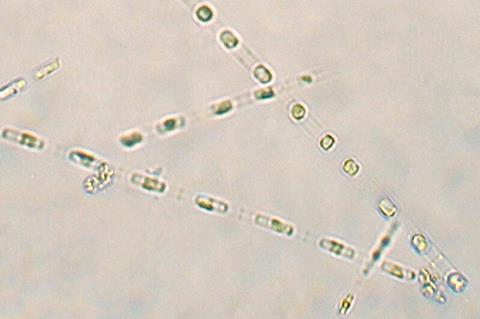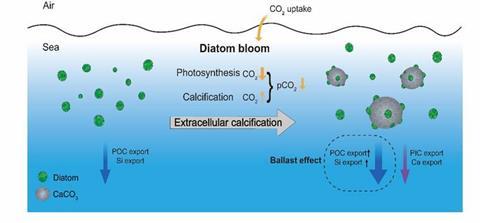A team led by associate professor Yiwen Pan, of the Institute of Ocean College, Zhejiang University, has found that the photosynthesis of Skeletonema costatum (S. costatum), a common diatom species, can induce substantial aragonite precipitation from artificial/natural seawater under significantly lower supersaturation levels required for the precipitation of inorganic CaCO3.

Researchers, publishing in Science Bulletin, have discovered that during the growth process of S. costatum, there is a significant decrease in total alkalinity (TA) and [Ca2+] in the bulk medium. The precipitated white particles were confirmed to be aragonite crystals through X-ray diffraction.
Scanning electron microscope images revealed that the diatom cells were enveloped by spherical crystals with diameters ranging from 40 to 70 μm, forming aggregates of S. costatum and aragonite.
Extracellular calcification process
Further investigations found that this extracellular calcification process is primarily driven by the combined effect of elevated extracellular CO32- concentration and the adsorption and aggregation of Ca2+ during photosynthesis.
This enables S. costatum to induce substantial aragonite precipitation at significantly lower supersaturation levels than those required for inorganic CaCO3 precipitation.
The team also observed TA deviation from the conservative mixing during S. costatum blooms in the East China Sea. This further supports the possibility of a new diatom-mediated calcification pathway occurring in the ocean.
Carbon cycling
This breakthrough finding has profound implications for our understanding of oceanic carbon cycling. Diatoms are the most important primary producers and organic carbon transporters in the ocean.
The newly discovered diatom-mediated extracellular calcification pathway may establish a novel connection between the particle inorganic carbon pump and the organic carbon pump.

On one hand, the release of CO2 during the extracellular calcification process is considered as ’counter carbonate pump’. However, in the diatom-mediated extracellular calcification process, due to the maintenance of high pH in the water, the released CO2 may be more readily absorbed by algae, rather than being released into the atmosphere.
On the other hand, the calcification, through the formation of aggregates of diatoms and aragonite, enhances the efficiency of organic carbon sinking and increases the transport capacity of the biological carbon pump.
This study not only changes our understanding of carbon cycling in marine ecosystems but also provides new perspectives for the ocean carbon cycle research, the researchers say.







No comments yet